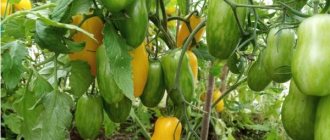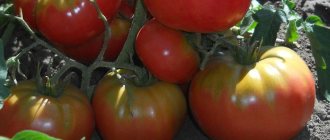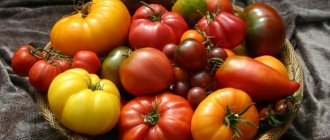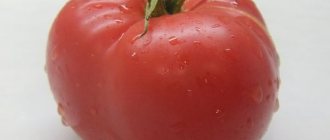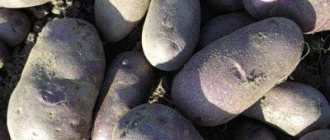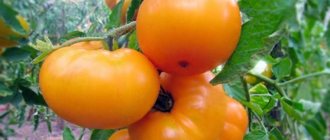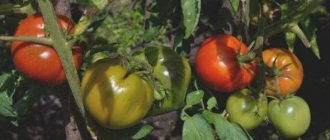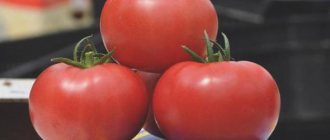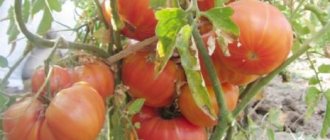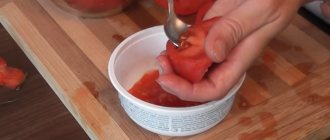» Vegetable growing » Tomatoes » Tomato varietal characteristics Slot F1
0
3297
Article rating
Tomato Slot is the optimal combination of good taste, endurance and excellent fruiting. This hybrid variety of tomatoes has long been enjoyed by many lovers of growing vegetables in their gardens.
- Advantages and disadvantages
- Growing
- Landing
- Care
- Reviews from gardeners
Tomato varietal characteristics Slot f1
Appearance and description of the variety
The “Slot f1” tomato of the universal type belongs to the standard determinate plants. The bush reaches 1-1.5 m in height. It is recommended to grow it in open soil. The best climatic conditions for this variety are in the southern regions: Crimea, Astrakhan, Krasnodar and nearby areas. In the middle zone, it is better to grow tomatoes under film.
Preparing seeds, planting seeds in boxes and caring for them
It is better to purchase seeds in a specialized store. You can, of course, buy ready-made seedlings.
The speed of the onset of the flowering period depends on the quality of the seedlings. If you still prefer seeds, then it is better to sow them in boxes with drainage holes in March. The containers are filled with nutritious soil, which contains peat, sand or garden soil. It is advisable to add wood ash to the soil.
5-6 days after sowing, the first shoots appear. The place for seedlings should be lighted and warm (18-22ºС). Water strictly at the root and only as needed. After 40-45 days from the moment of sowing, the sprout becomes longer and the leaves increase significantly. About 2 weeks before transplanting tomatoes to a permanent location, begin to gradually harden them.
Seedlings and planting in the ground
As soon as there is frost, incl. night, behind, you can start planting seedlings in open soil. It is recommended to place 4 bushes per 1 m2. Dense planting is the reason for poor ventilation and low yield of tomatoes.
Take care of the garter in advance: stick a stake into the hole in addition to the plant. The land must also be prepared in advance. Mix its top layer with humus and wood ash.
Care and watering
Until the first ovaries appear, water the plant up to 4 times a week, and then every day early in the morning or late in the evening. Later, the frequency of watering is reduced to once every 7-10 days. Don't forget about loosening the soil. The bush forms new roots only if there is periodic hilling.
Once every 2-3 weeks, tomatoes need to be fed. Phosphorus has a positive effect on the immune system, and potassium has a positive effect on the taste of fruits, and also protects against pests and diseases. The first is applied before planting or in winter, depending on the type of fertilizer. Nitrogen fertilizers are applied at the early development stage.
Complex fertilizers are also suitable for feeding the Slot f1 variety. During the season, it is necessary to fertilize with organic matter and minerals twice. To do this, use humus or mullein and ash.
In addition, tomatoes also need a garter to avoid breaking off. Pinching is also an important part of plant care. As the tomato grows, it forms 2 stems, one of which should be removed. Removal must be complete, that is, to the base, when the stepson has reached 4 cm. The “stumps” that inexperienced gardeners can leave from the second stem contribute to the development of microbes and rotting of the plant.
If pinching is not carried out, fruits will begin to form on the side shoots. Since the plant does not have enough strength to develop both stems, due to the lack of necessary nutrients, the lower tomatoes will begin to rot.
Pests and diseases
Do not wait for the onset of any of the diseases, carry out prevention. 3 preventive treatments per season are enough: at planting, during flowering and fruit formation.
The variety is susceptible to brown spot. This is a fungal disease that appears as yellow spots and a coating of spores. The lower leaves are the first to suffer, and over time they curl and dry out. The most favorable period for the development of the disease is the periods of flowering and fruiting. An effective drug for combating brown spot is “Barrier” or Bordeaux mixture.
In addition to this disease, the tomato also suffers from powdery mildew - small round white spots. As the spots increase in size, their color first becomes yellow and then brown. In this case, the drug “Profi Gold” will help you.
Overfeeding a plant with nitrogen fertilizer provokes the occurrence of phytotoxicity in the soil. If this happens, just take a break from fertilizing and let the soil rest.
They prefer the variety “Slot f1” and Colorado beetles. They are very easy to spot, as they are striped bugs. Yes, exactly those that live on potatoes. You can fight them with the drug “Prestige”. Another pest is the mole cricket. “Gnome” helps against her very well.
Rules of care
The Slot tomato variety is an excellent combination of compactness, productivity and endurance.
At the growth stage, it is necessary to apply a complex fertilizer with a high content of potassium and phosphorus. In particular, potassium fertilizers affect the taste of tomatoes and increase the plant’s immunity, and phosphorus compounds (they are applied before planting, preferably for the winter) are needed by the plant for natural photosynthesis.
Regarding soils, the variety is undemanding in terms of humus composition, the main thing is that they are light and breathable, and the area is well lit.
Slot tomatoes are watered in the same way as other varieties of tomatoes, namely once every one and a half to two weeks. It is worth remembering that if the plants have enough moisture from natural precipitation, watering is not carried out, since excessive soil moisture can cause rotting of the root system.
It is also worthwhile to carry out pinching regularly - you should not leave more than 2 main stems and stepsons on the bush. Such layering draws juices and nutritional components from the plant, weakens it, and acts as a breeding ground for microbes and pathogenic microflora.
Planting scheme: 3-4 bushes per square meter. The main thing is not to plant them densely, giving enough space for growth and development.
Preparing to sow seeds
The timing of planting tomatoes (sowing seeds) depends on how many days pass from sowing to the ripening of the fruit:
- early varieties - 100-120 days;
- mid-season varieties - 110-130 days;
- late-ripening varieties - 130-140 days.
In the central regions of Russia they are sown from mid-March to early April, in the southern regions you can start in mid-March, and in the northern regions and Siberia it is better to wait until mid-April. It is necessary to expect that, on average, at least 2 months should pass from planting seeds to planting seedlings in a greenhouse or open ground. Let's look at how tomato seeds are prepared for planting.
Soil preparation
The soil for seeds should be light, well absorbent and retain moisture, without bacteria and fungal spores. It's better to do it yourself.
- Mix garden soil with sand and peat in the following proportion: 2 parts soil, one part each sand and peat.
- Spill with boiling water, a solution of potassium permanganate (2%) or Fitosporin-M for disinfection, or calcinate the mixture in the oven.
- The garden soil is cleared of larvae and weeds.
Seed preparation
There are raw and processed (granulated) tomato seeds on sale.
Non-granulated seeds are prepared for sowing in the following way:
- Disinfect for half an hour in a solution of potassium permanganate (2%) or 2 hours in a solution of Fitosporin-M (half a teaspoon per 100 ml of water).
- Wash with water at room temperature and dry.
- Place on a cloth moistened with water or any growth stimulant, for example, aloe juice (dissolved in water 1:1), cover with the same wet cloth and place in a container with a lid.
- Place in a warm place and ventilate periodically.
- After the seeds hatch (usually on the 3-5th day), they are sown in the ground.
Let's start landing
First of all, you need to thoroughly moisten the soil in pots or boxes with seedlings. This will help you easily remove them from the seed container and prevent accidental damage to the root system.
Prepared holes for growing tomatoes in open ground should have a depth of 10-15 cm.
We water them (a bucket of water for 8-10 holes) and apply mineral fertilizers mixed with humus (proportion 1x3).
- Turn the container with the seedlings over, wrap your middle and index fingers around the tomato stem and remove it from the container.
- Tear off the leaves of the seedlings, leaving only 2-3 leaves on top (this will stimulate root growth).
- Place the plant with a ball of root soil vertically in the hole and sprinkle with compost. In this case, the tomato stem should remain open. Only the roots or soil pot are placed in the ground.
- Press the soil firmly around the plant and cover the compost with dry soil.
- After planting, mulch the soil (cut, slightly wilted grass, sawdust, straw or newspaper leaves are suitable for this). The mulch layer should be about 10 cm high.
When planting tomatoes in the ground is finished, we will leave them alone for 8-10 days. During this period, the plants take root and become accustomed to the new location.
There is no need to water them yet. But you need to be prepared for frost. To do this, immediately after planting, we will cover our young tomatoes with transparent film.
It will remain until the threat of frost disappears (for the middle zone this usually happens by June 5-10). You can make holes in the film with a diameter of 10 cm. This will reduce the risk of late blight infection.
After 10 days, we water the seedlings and at the same time plant a new one in place of the dead one. The first hilling when growing tomatoes in open ground can be done two weeks after planting the seedlings.
In the future, we will hill up the plants as they grow.
Features of cultivation
Tomatoes of the hybrid variety Katyusha grow faster if they are planted in seedlings on the plot, having previously germinated the seedlings at home at a suitable temperature (not lower than +18°C). Transplanting seedlings to a garden bed will also not take much time, especially if you take into account all the recommendations for preparing the soil and performing the procedure itself.
Growing seedlings
The process of sowing tomato seeds for seedlings consists of the following steps:
- Find a suitable container (box or container) and fill it with a mixture of equal parts of garden soil, sand, humus and leaf soil. To fertilize the finished substrate, you can spill it with a solution of urea (10 g), superphosphate (30 g) and potassium sulfate (25 g), pre-mixed with 10 liters of water.
- Treat the seeds prepared for planting (you need to select only large and heavy specimens, without the slightest sign of damage) in a weak infusion of potassium permanganate or a growth stimulant, which will protect them from fungal spores and activate the growth of the rhizome.
- Make 2-centimeter depressions in the soil poured into the container and place the seeds, slightly dried after processing, into them.
- Sprinkle them with a small amount of soil and water with moderately warm, settled water.
- It is worth adding a little more earthen mixture to the soil that has sagged from moisture to make the soil surface as level as possible.
- Cover the crops with thick polyethylene and take them to a well-lit place with an air temperature of at least +22°C.
Further care for seedlings emerging from the soil is based on timely moistening of the substrate from a spray bottle (a crust should not appear on the surface of the soil) and regular ventilation by removing the cover daily for 1–2 hours. After 2 weeks of such cultivation, the film can be completely removed, and as soon as 2 leaves are formed on the plants, they can be packed into separate peat pots or disposable cups.
2-3 weeks before planting in open soil, tomato sprouts begin to harden, taking the boxes out onto the balcony or terrace every day. They should stay here for at least 2–3 hours a day, gradually getting used to the lower temperatures and wind.
Preparing the soil for planting seedlings
They begin to prepare the site for planting tomatoes of the hybrid Katyusha variety in the fall, thoroughly digging and loosening the substrate in the chosen place. To increase its nutritional value, you can add compost or humus to the ground, as well as add superphosphate (3 tablespoons), potassium sulfate (1 tablespoon) and wood ash (2 cups), per 1 m² of territory. In soils that are too acidic, it is also useful to add dolomite flour or lime (for digging), since tomatoes of the described variety prefer neutral soils.
With the arrival of spring, the soil in the garden bed is fluffed up again, and then the places for planting the grown seedlings are marked, making holes at a distance of 50 cm from each other. There should be at least 60 cm of free space between adjacent rows.
Technology of planting seedlings
The process of planting grown seedlings in open soil consists of a set of standard actions:
- To begin with, according to the diagram above, dig holes.
- Carefully remove young plants from the seedling containers.
- Place each of them in the center of the planting hole, straighten the rhizome and cover with soil.
- Water the plantings with settled water and mulch the bushes with sawdust or peat.
Tomato “Slot F1”: variety description
This is a medium-late variety; 115-120 days pass from the moment the seedlings are planted until the first fruits ripen. The plant is standard, determinate, the height of the bush is 100-150 cm. The variety is recommended for cultivation in open ground, but some achieve results under film covers, and even try to grow it on balconies. There are F1 hybrids of the same name. This type of tomato has fairly good resistance to Alternaria.
Fruits that have reached varietal maturity have a bright red color and are rounded and flattened in shape. The average size of the fruit is 60-70 g, later the size of the fruit decreases to 50-55 g. The number of chambers in the fruit is 2-3, the dry matter content is approximately 4%. The collected fruits tolerate long-term storage and transportation well.
The variety “Slot F1” was obtained by Russian specialists and received state registration as a variety for open ground in 1999. Since that time, it has enjoyed deserved popularity among summer residents and owners of small farms.
You can compare the weight of fruits of the Slot variety with others in the table below:
| Variety name | Fruit weight (grams) |
| Slot F1 | 60-70 |
| Broody | 90-150 |
| Andromeda | 70-300 |
| Pink Lady | 230-280 |
| Gulliver | 200-800 |
| Banana red | 70 |
| Nastenka | 150-200 |
| Olya-la | 150-180 |
| Dubrava | 60-105 |
| Countryman | 60-80 |
| Golden Jubilee | 150-200 |
Tomato Slot: description of cultivation
To prevent tomatoes from dying in the first days of their life, in our region they must be grown exclusively by seedlings. Seedlings of these tomatoes are grown in a standard way: treatment with disinfectant liquid and growth stimulants, planting in boxes, planting in separate containers, first feeding.
Before you start growing Slot tomatoes, you should consult with professionals and watch a training video
Rules for planting and caring for tomatoes Slot:
- After the night and morning frosts have passed, you can plant the seedlings in open ground. For one sq. No more than 5 plants can be placed per meter. Near each hole you need to stick a peg, and mix the top layer of soil with humus and ash.
- As the tomato bush grows, form it into two stems. Removing stepsons to the very base.
- Long before planting, saturate the soil with phosphorus-containing fertilizer. It is better to do this in the spring, as soon as the snow has melted. If you were unable to saturate the soil in time, use fast-acting superphosphate.
- Potash fertilizers will not only protect tomatoes from plant diseases, but will also give the fruits a more pronounced taste.
- Twice a season you need to make mineral-organic fertilizing consisting of humus or cow grass and ash.
- The Slot needs to be watered once every 10 days with settled warm water. If you overwater the plant, it may develop fungal diseases or even rot.
- If jelly spots have formed on the leaves of your tomato, and there is a white coating on the back side, then most likely it is brown spot. Over time, from such a disease, all the leaves will turn yellow, curl into a tube and dry out. To cure a plant, it must be treated with Zaslon or Bordeaux mixture. This disease can be caused by watering tomatoes with too cold water.
- When tomato leaves look like they are stained with flour, they urgently need to be saved from powdery mildew. Otherwise, the leaves will turn brown and wrinkle, causing the plant to die. Treat it with Profi-Gold.
- Slot is also very fond of Colorado potato beetles and mole crickets. You can get rid of the beetles with the help of Prestige, and the Dwarf will save you from the mole cricket.
As you can see, caring for Slot tomatoes is not much different from growing other, undemanding tomatoes. Fertilize and treat against diseases in a timely manner, and your reward will be a tasty and abundant harvest.
Description and characteristics of the variety
Slot tomato F1 Semko is a mid-late hybrid with extended fruiting; harvests from it can be harvested right up to autumn frosts. Ripening time begins after 115-120 days from germination.
- average weight 100-150 g;
- the shape is round and slightly flattened;
- color deep red;
- the pulp is oily, moderately juicy, with a dense texture;
- the skin does not crack;
- 3 seed chambers, few seeds.
- shoot height 100-150 cm;
- bushes are compact, moderately spreading;
- need shaping;
- 5-6 tomatoes ripen on a bunch.
Country of origin and year of registration
The hybrid variety was bred by breeders from Russia. Included in the State Register since 1999. It bears fruit successfully throughout the country. Initially intended as a hybrid for unprotected areas.
Which regions are best to grow in?
It is planted on an industrial scale in large areas in temperate latitudes, in the south - in the Krasnodar, Astrakhan Territories and Crimea. Can be grown in greenhouses in more northern regions.
How to prepare for sowing
Preparatory work is a serious stage that cannot be neglected. It is necessary to prepare both seeds, soil, and planting containers.
With seeds there are two options for the development of events.
1. Option one – purchased seeds processed by the manufacturer. In this case, if the seeds are impregnated with any disinfecting or stimulating composition, enclosed in a capsule or hard shell, they do not need to be prepared for sowing. Information about this must be indicated on the packaging.
Tomato seeds
2. Option two - you collected the seeds yourself (took them from someone) or bought them packaged, and there are no instructions on the bag, but in appearance the seeds look quite normal. They need to be prepared.
Self-collected seeds
Both pots and soil must be disinfected in both cases.
The easiest way to disinfect pots is with soda, soap or potassium permanganate solution. It can be kept hot for greater effectiveness.
Potassium permanganate solution for disinfection
For soil disinfection, the most suitable method is also to pour a hot solution of potassium permanganate through it. To do this, place the soil in a colander or something similar. You can do without potassium permanganate by heating the soil, filled with water, in a microwave or oven, or freezing it in the freezer.
What is the best way to disinfect the soil?
Composition of soil for tomato seedlings:
- turf soil - 1 part;
- peat – 1 part;
- river sand – 1 part;
- superphosphate – 1 tbsp. for 10 liters of soil;
- ash – 4 tbsp. per 10 liters of soil.
Seed disinfection
There are many ways to disinfect tomato seeds. Here are the most popular ones.
- Potassium permanganate, one percent solution. Seeds, wrapped in a cotton cloth or gauze, are kept in a warm disinfectant for 20 minutes. Then washed.
- Aloe juice. This method helps not only to disinfect the seeds, but also to stimulate their germination. The juice should be from the stems, cut ahead of time, two weeks before soaking, and placed in the refrigerator. The seeds need to be kept in the juice for 12 hours.
- Fitosporin. One percent solution. The seeds are kept in it for an hour.
Protection from diseases and pests
The most dangerous disease for tomatoes is late blight. Bordeaux mixture is used to protect against this disease. Processing is carried out in two stages:
- when fruits appear and fill on the first cluster;
- repeated - with an interval of 2 weeks.
To treat the disease in the initial stage, copper-containing drugs are used, for example HOM, Oxychom. Also, there are many other methods to combat this disease.
You can save fruits that have begun to ripen, but have been affected by late blight. To do this, they need to be collected and dipped in hot water (60 degrees) for a minute, and then cooled sharply. After this, the tomatoes can be stored for a short time, or ripened in a warm room, and will not deteriorate further.
You will find the most common tomato diseases with photos and descriptions in our material.
Nightshade pests carry diseases and cause irreparable damage to the crop. Growing tomatoes may be in vain if you do not treat the plants against parasites and allow them to multiply.
Whitefly (lat. Aleyrodidae)
A white butterfly resembling a moth is a whitefly. Plantings are destroyed within a few weeks. The preparations Fitoverm and Aktara will help - you need to spray the underside of the leaf. The procedure is carried out repeatedly, at weekly intervals.
Tomato rust mite (lat. Aculops lycopersici)
Creates cork-like growths on tomatoes. The fruit becomes inedible. The only chemicals that help against insects are Kemifos, Atellik, Vertimik, Fitoferm.
Spider mite (lat. Tetranychidae)
During its life, spider mites leave yellow and white dots on the back of the leaf, which cause fungal infection. Chemicals for insect control: Agrovertin, Anti-mite. Folk remedies include treatment with tinctures of dandelion, garlic, and tobacco.
Also, the mole cricket causes irreparable damage to the crop. You can read about ways to protect yourself from this parasite in our article.
Disease susceptibility
The description of the variety confirms the plant's resistance to some common diseases. For example:
- Tobacco mosaic.
- Macrosporiasis.
- Black bacterial spot.
Most often, the plant suffers from brown spot and powdery mildew. Timely treatment with drugs will help to avoid a reduction in the volume of the harvest and the death of the plant itself.
Insect pests:
- Colorado beetle.
- Medvedka.
- Rusty mite.
To combat them, it is effective to use treatment with special preparations that are sold in agricultural stores.
Harvest and storage
According to gardeners, the harvest ripens at the end of July, but the first tomatoes can be picked earlier. Fruiting lasts until mid-autumn, but it is better to harvest tomatoes at the end of September. When temperatures drop, tomatoes can become sick and spoil. It is recommended to pick them brown and then ripen them at home.
Due to the large size of the fruit, the shelf life of this variety is average. Fully ripened tomatoes are best stored in the refrigerator for no more than a week. Brown unripe fruits lie for about a month in a cool, dry place.
Tomatoes of Siberian selection. Heavyweights Nobleman and Superbomb
tomato Superbomb and hybrid Stesha F 1.the best varieties of tomatoes
Stesha and Superbomb tomatoes .June 18 brief review
Positive and negative sides
The presence of a large number of negative characteristics discourages the desire to purchase seeds for your plot. But Slot tomatoes have virtually no downsides.
Pros:
- Resistant to the vagaries of nature (in particular heat).
- Very productive.
- The taste is excellent.
- Tolerates lack of moisture well.
- Seeds collected from fruits are not suitable for independent propagation.
- At the growth stage, tomatoes are capricious regarding feeding.
Minuses:
Brief information about the variety
- Fruits and bush: medium-sized tomatoes, weight of one copy is 120 g, color chocolate brown, with a pink tint; determinate bush, medium leafy, height – 70-120 cm.
- Productivity: the Gypsy variety is high-yielding (4-5 kg of fruits are collected from one bush).
- Resistance: the plant is moderately resistant to diseases and pests and requires preventive treatments.
- Distribution: when grown in greenhouse conditions, the variety can be cultivated in any region of the country. For open ground, tomatoes are used in southern regions with a warm, mild climate.
- Application: the fruits are universal (suitable for fresh use, as well as for canning).
- Planting: use the seedling method; the timing of sowing seeds is March or early April; transfer of seedlings to the ground occurs in May or early June; The recommended planting pattern is 50x70 cm.
- Soil: fertile, loose, saturated with nutrients, previously disinfected.
- Care: the crop requires moderate watering, the application of organic and mineral fertilizers, the formation of a bush of 2-3 stems, and regular pinching. When growing in greenhouses, it is advisable to tie the bush to a support.
- Ripening period: average, 110-115 days pass from the moment of sowing the seeds to harvesting the first harvest. The shelf life of the fruits of the Gypsy variety is short.
Characteristics of tomato
Tomato Slot f1 was obtained in 1999 by domestic breeding specialists. Very quickly the variety gained recognition among vegetable growers. This type of tomato develops most successfully in warm regions of our country. In areas where the summer period does not offer many warm days, the heat-loving crop is cultivated in greenhouses. Film cover does not affect the quality and quantity of the harvest.
Planting 4 plants per 1 square. m, you can remove up to 7 kg of marketable vegetable products from one bush. The hybrid ripens together, the plant belongs to determinate specimens, its growth under favorable conditions reaches 100 cm. The bushes require gartering and pinching. The leaves are medium sized, light green in color.
The first month of spring is considered the optimal period for sowing tomatoes. Slot f1 is sown in special boxes that have drainage holes
The main advantages of the variety: productivity, excellent resistance to heat, good transportability and endurance to temperature changes. The tomato does not tolerate poor soils well - this is perhaps the main drawback.
The first ripe tomatoes grow on the bushes 100-110 days after emergence. The fruits have a rich red color and a rounded-flattened shape. Vegetables formed on the lower branches reach 100 g, those fruits that grow higher gain weight 10-20 g less. The taste of the vegetables is pleasant, with a bright tomato aroma, the skin of the fruit is hard and dense. Vegetables are suitable for any preservation; they make delicious salads, sauces and tomato pastes.
The plant is resistant to many diseases; it is not affected by macrosporiosis, tobacco mosaic and black bacterial spot. Dense planting of bushes and watering with cold water can provoke certain fungal diseases in plants. Necessary preventive procedures save the foliage and fruits of the crop from this scourge.
Brown spotting is a common problem that occurs during sudden temperature changes. This phenomenon is observed during the period of flowering and initial fruiting; Bordeaux mixture or the special drug Zaslon will help prevent the disease.
Rules for choosing a variety
The name of the Nepas variety comes from the word nepasynkuyuschiy, which plays an important role in the process of growing tomatoes and caring for them
When planting tomatoes, everyone decides on the choice of variety based on their needs: some care about taste, others pay attention to size and shape.
When choosing a subspecies from this series (they all have different characteristics), you need to consider some factors:
- size. Those for whom the large weight of the fruit is important should take Nepas 14, 12, 10, 7. All other varieties are either cocktail or cherry;
- taste. Almost all subspecies have the sourness characteristic of this variety, but the taste does not suffer from this;
- fruit color. It is different for all varieties. Usually the seed packet shows the approximate shade of the tomatoes;
- type of bush. The variety is non-sapling, standard, as a result of which the plant height is small - from 40 to 80 cm (depending on the variety);
- resistance to diseases. Tomatoes of the Nepas series are hybrid, therefore they have good immunity;
- growing conditions. The variety is determinant, adapted to temperature fluctuations, and can grow in open ground. Not afraid of direct sunlight and cold (develops well at 18-20 °C).
Characteristics and description of the variety
The hybrid variety Katyusha was first heard of in 2001, when it was included in the State Register of Cultivated Plants as a variety recommended for planting in open and closed soil. Since that time, many gardeners have become convinced of its merits, which is why the large-fruited hybrid tomato Katyusha is increasingly found on plots. At the stage of full maturity, the fruits weigh at least 120 g each. All of them are characterized by pink or hot pink color and round shape. Inside there are 6–8 chambers with seeds, in which about 5% of their composition is dry matter.
The skin of the fruit is always dense and smooth to the touch, and perfectly protects tomatoes from cracking, even during long-term transportation. If the requirements for growing vegetables are met, up to 7 kg of fruit can be harvested from 1 m² of plantings, with excellent taste characteristics: the pulp perfectly combines sweetness and slight sourness, with light spicy notes. Thanks to this, hybrid fruits can be used to prepare ketchup, tomato paste and various sauces, although their use is not excluded fresh (in salads). The height of the plant itself varies from 80 cm in open soil to 1.3 m in a greenhouse.
Harvest volume and application
With proper care, Slot f1 tomatoes produce good yields. From one plant you can harvest from 5 to 7 kg of tomatoes. The description shows that 1m2 produces from 20 to 28 kg of fruit.
The scope is varied, excellently used for pickling and salting. In addition, it is suitable for preparing fresh salads. Juices and tomato paste are no worse than when using other varieties of tomatoes.
See also
Description and characteristics of the tomato variety Sladkoezhka, its yieldRead
Growing seedlings
To keep the bushes healthy and strong, the seedling method is used when growing. Also, thanks to it, it is possible to get an early harvest, especially when cultivating plants in a greenhouse.
Seed preparation
One of the positive properties of Gypsy tomatoes is the high percentage of seed germination. Before sowing, the material must be properly prepared. This will speed up its germination and increase the seedlings’ resistance to fungal diseases.
Preparation stages:
the seeds are sorted, rejecting low-quality and hollow specimens. The material is placed in a warm, weak solution of table salt - healthy and full-bodied seeds sink to the bottom, and defective ones remain on the surface of the composition; the selected seed is placed for 15-30 minutes. into a pink solution of potassium permanganate, then washed and dried. This procedure disinfects the seeds, destroying harmful bacteria on them; For more active development of tomato seedlings, their seeds are pre-germinated. They are placed in a humid environment (napkin, cloth, gauze bags) for 1-2 days for the sprouts to swell and peck.
It is important to prevent the material from drying out during this period.
If you use seeds from the manufacturer (they have a colored shell) and not collected by hand, additional processing is not necessary. They are already disinfected and saturated with nutrients necessary for the development of seedlings.
Planting seeds for seedlings
The time for sowing seeds of the Gypsy variety for seedlings is March or early April. Prepared seeds are sown in common boxes or immediately in separate containers. In the second case, there is no need to pick up the seedlings, which eliminates possible mechanical damage to the plant root system.
Soil for sowing can be purchased at gardening centers or prepared yourself. To do this, mix garden fertile soil and humus in equal parts. The soil mixture must first be disinfected (hold it in the oven for 20 minutes or pour it with a solution of potassium permanganate).
Stages of sowing seeds:
- the soil in the containers is moistened in sufficient quantities with warm, settled water using a sprayer;
- the seeds are placed at a depth of 1-1.5 cm. The distance between them should be 2-2.5 cm;
- boxes or pots are covered with film, placed in a warm place (22-25 °C) until seedlings emerge, after which the film material is removed and the seedlings are transferred to a lighted place.
Care
To obtain high-quality seedlings, seedlings must be properly cared for. The main requirements are sufficient lighting, moderate and regular watering and stable temperature.
To water Gypsy tomatoes, they use warm water, adding it to the soil with a spray bottle so as not to wash the fragile sprouts out of the soil. Moistening is carried out as the soil dries, preventing the formation of an earthen hard crust.
The daytime temperature in the room should be 19-24 °C, night - 15-16 °C. In case of insufficient lighting, phytolamps are additionally used.
7-10 days before transplanting seedlings into greenhouses or beds, they are hardened off. The essence of the process is to place containers with seedlings in fresh air every day with a gradual increase in the time they spend there. This will allow the plant to quickly adapt to natural conditions in the future.
Growing
Tomatoes are easy to care for
Tomatoes Slot F1, like most other varieties of tomatoes, should be grown using seedlings. Before sowing, it is recommended to treat the seeds with a weak solution of potassium permanganate and a growth stimulant.
Treated seeds are sown in suitable containers. The quality and hardening of the sprouts subsequently influence the beginning of flowering and, accordingly, the ripening of tomatoes.
Landing
According to the description, seedlings can be planted in protected soil at any time in the spring, and young plants should be transferred to open soil only when the night frosts have finally gone away.
When planting, you should immediately take care of supports for the bushes and place stakes next to the holes for tying up the stems. It is also advisable to prepare the soil in advance and fertilize it with wood ash and humus.
Watering
It is advisable to water tomato bushes growing outdoors every day (in the morning or evening). In the future, the frequency of watering should be gradually reduced.
Feeding
At the growth stage of tomatoes, they need mineral fertilizers containing nitrogen. During the flowering phase, tomatoes are fed with phosphorus-potassium fertilizers. At the fruiting stage, potassium sulfate is added.
Disease and pest control
Tomato Slot is generally resistant to common diseases and pests, but you should not wait for possible problems to appear. To avoid damage to plants, it is better to carry out several preventive treatments of bushes against brown spot, powdery mildew, Colorado potato beetle and aphids.
According to the description of the variety, the plant is immune to tobacco mosaic, bacterial black spot and macrosporiosis.
Characteristics of the variety
Slot tomatoes are an early tomato variety.
Description of the bush
The bushes are quite tall and grow up to 100-120 cm. There is no need to pinch the tops: their growth stops on their own. Branched bushes. They grow well both in greenhouses and in open beds.
To get a sufficient number of fruits, the plant needs to be pinched. Usually the bush of the Slot F1 variety is formed into 1-2 stems. Excess shoots should be removed near the root. If this is not done, then the plant simply cannot cope with the nutrition of all the fruits that have set and they will die. The remaining stems of the bush need staking.
If you do not prun the tomato plant, then no death will occur. The fruits just won’t have time to ripen (in cold regions) or will be small.
Description of fruits
The size of the fruits is average, their weight ranges from 100 to 150 g. Tomatoes that ripened on the lower clusters have a larger mass, and fruits collected from the top weigh less. According to the characteristics, tomatoes have a juicy red color and a round, slightly flattened shape.
The taste of the fruit is very pleasant, with a slight sourness. Although the skin of tomatoes is thin, it does not crack.
Productivity
Gardeners note that under favorable weather conditions and following all the rules of agricultural technology, it is quite possible to get up to 10-11 kg of fruit from one tomato bush, which is a good characteristic of the variety.
In protected ground you can get about 15 kg of fruit. The dense arrangement of tomatoes in the garden negatively affects the yield: the plants do not have enough space for normal development. Therefore, the recommended planting density is 4 pcs. per 1 m² of land.
Application area
Tomatoes of the Slot variety can be used both for canning and for fresh consumption. They are juicy and meaty. They make salads, side dishes and many other dishes.
Housewives prepare delicious juices, sauces, ketchups from tomatoes, and add them to hot dishes. The description states that the tomatoes are well transported.
Planting and caring for the plant
They are grown only by seedlings. Seeds are planted in containers in March. You can add a little wood ash to the soil mixture. It contains potassium and phosphorus, which are necessary for young growing tomatoes.
Then, after the appearance of 2 full leaves, they are picked. It is important to timely fertilize the plants. This is done in order to give more strength to the young plant.
After planting in the ground, it forms 1–2 trunks. All excess stepsons are cut off. There is no need to remove the growth point. The plant regulates its height independently. There are up to 4 bushes per 1 m2.
The plant needs a garter due to the large number of fruits on them. To avoid breaking branches, it is better to secure it on supports in a timely manner.
Caring for high-yielding tomatoes
We monitor the load of plants directly with fruits and adjust it in a timely manner, taking into account the characteristics of the variety.
It is advisable to carry out agrotechnical regulation of the development of bushes only if they have a balanced mineral nutrition.
Note! Experience shows that it is better to limit nitrogen before the formation of the first cluster of fruits, especially in plants with vegetative development
- During the growing season, we regularly apply, as the instructions recommend, phosphorus-potassium fertilizers, during flowering and a little later - phosphorus fertilizers, and for fruit growth - potassium and nitrogen fertilizers.
- 1 week before planting the seedlings in the garden greenhouse, stop feeding them, and after planting, we will do the first feeding 2 weeks later.
- In case of excessive vegetation, we apply foliar feeding on the leaves - an extract from superphosphate, as well as root phosphorus-potassium fertilizer.
- With accelerated generative development, we will do 2 feedings with fermented weeds - this will speed up the ripening of unexpectedly numerous fruits in cool weather.
- The seedlings need very loose soil, so add 30% peat to the black soil. But a mixture with vermicompost and perlite is ideal for this: we pour it, compacting it, into boxes and water it, as a result it will sag. Here we sow 1 seed every 5 cm (depth - 1.5 cm).
Seedling care
- The shoots will appear in a week, and we will lower the temperature to +18C.
- Water with warm, settled water once every 3 days.
- To rid the sprouts of root rot, we use biological products.
- When a true leaf appears, place the seedlings one at a time in plastic or peat pots.
Plant care
We place the seedlings in a row on the ground every 50 centimeters, and 60 cm between their rows.
Note! We place seedlings of large-fruited tomatoes in heated shelters 50 days after germination, and in unheated shelters in May
- Add 1 tablespoon of calcium nitrate or 2 cups of humus into the hole.
- We tie up the overgrown bushes with a trellis, thrown over a 5 mm wire stretched along the rows.
- Next, we simply twist the trellis with our own hands as the bush grows, water it, and after flowering, feed it with ready-made balanced organic matter 2 times a month.
- We will tie up large-fruited tomatoes - these high-yielding varieties need such support.
- We regularly remove shoots from the leaf axil.
We collect fruits that are brown, since their complete redness depletes the plant.
Experienced gardeners experiment with several varieties of tomatoes at once, because a specific soil and region have their own productive hybrids.
- When choosing varieties, we take into account the characteristics of the greenhouse and growing conditions.
- Traditional and proven greenhouse tomatoes are good, but new varieties are more hardy and productive with easy care.
- We buy large packages of the selected variety and plant 50 seeds; if the result is successful, we sow the remaining seeds.
We are guaranteed to get a wonderful harvest of organic tomatoes in a garden bed in a greenhouse by observing simple conditions:
- we feed the seedlings,
- we fertilize the sprouts already planted in the ground,
- we plant the stems,
- protect against late blight.
The video in this article has more information about high-yielding tomato varieties.
Features of tomato Octopus F1
This is a hybrid plant characterized by increased immunity and unlimited growth. The tomato tree can resist many ailments. Octopus F1 is a perennial plant that can reach a height of 5 m. In addition, it is very fertile - this is the main advantage of the hybrid. The fruits are small and round in shape (the weight of each tomato ranges from 100 to 150 g). But to get a big harvest, you will still need to adhere to a special plan of action.
Tomato tree Octopus F1. Photo
There are some features that need to be taken into account when growing this hybrid. When choosing the first growing method, the technology is no different from planting ordinary tomatoes: the seeds are planted in a container, then the seedlings are moved to a greenhouse or open ground - it all depends on the climate. A tomato tree rewards the gardener with 12 kg of ripe fruit in one season.
The brush of the hybrid Sprut F1 is laid after two or three leaves. Each of them produces 5-6 fruits with an average weight of 100-160 grams
One tomato tree Sprut F1 can produce about 100 thousand tomato fruits during the year
The second method of cultivation is based on the use of special technology. In this case, the characteristics and characteristics of the plant must be taken into account. In this case, there are no restrictions on the growth of tomatoes, so in one season you can get more than 1 ton of tomatoes from each bush. Of course, this method is too labor-intensive, and it also takes more than 18 months. Special conditions are also needed, so many prefer the first method.
Another photo of a tomato tree
Another photo of a tomato tree
The opinion of summer residents regarding the “Slot” variety
More complete information about tomatoes is contained in the reviews. In them, summer residents share their experiences and give advice to beginners. They also express their own opinions.
- Arseny. Tomatoes have been planted for more than one year. They don't take much care of them. I really like the taste of fresh fruits.
- Angelina. Every year he always grows 5-6 tomato bushes on the plot. Almost everything is eaten. The remainder goes for processing.
- Marina. I didn't like the tomatoes. When fresh, the taste is very sour. During pickling, the skin burst, disrupting the structure of the fruit.
- Christina. He has been growing tomatoes for 5 years. For her, he is among the first among those required to board. I like it pickled and fresh. The characteristics are satisfactory. The only thing I don’t like is that you have to buy seeds every year.
- Valentina. I like the high yield of the plant. And 100% seed germination.
The unpretentious variety of tomatoes “Slot” has earned a good reputation among experienced summer residents. Many people recommend it to others, since their characteristics are only positive. And caring for him is no different from others.
See also
Characteristics and description of the Long Keeper tomato variety, its yieldRead
Tomato planting dates
The time for sowing tomatoes depends on the variety and on the temperature at which the seedlings can be transplanted into open ground. The average time before emergence is 5-10 days, and the period of aging seedlings on the windowsill is 55-65 days. Compliance with deadlines affects the uniformity of germination, strength and timely preparation of seedlings for the time of planting in open ground.
Conventionally, tomato varieties are divided into three temperature groups. If you sow seeds in open ground, you can navigate by the following parameters.
First group
Early ripening tomato varieties that are resistant to cold weather. Planting seedlings for this group is permissible when the temperature at night does not fall below 10 degrees Celsius, and during the day reaches 15. Usually this is the end of April - the beginning of May. During this period, the root system receives maximum moisture from the soil that remains after winter.
Second group
This includes mid-early tomato varieties. For the second group, planting seedlings at temperatures ranging from 15 degrees Celsius at night to 20 during the day is suitable. By this period, tomatoes are not afraid of frost, and there is still a sufficient amount of moisture in the soil.
Bush care
In open ground, bushes do not need to be pinched, but only tied to trellises. When cultivated in a greenhouse, partial pinching and pinching of the stem is required to form 5-6 inflorescences.
The rest of the rules of agricultural technology are standard:
- Moderate watering;
- Regular loosening of the soil and weeding;
- Mulching the beds;
- Complex fertilizing once every 2 weeks.
